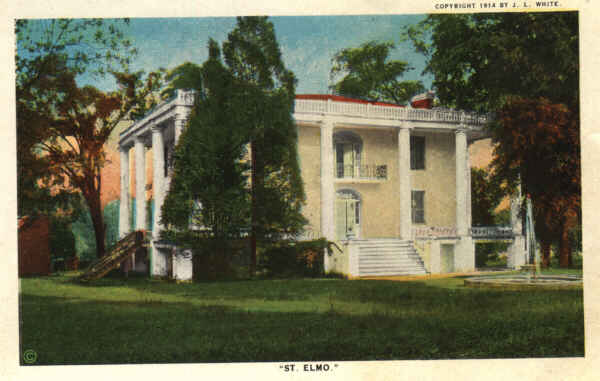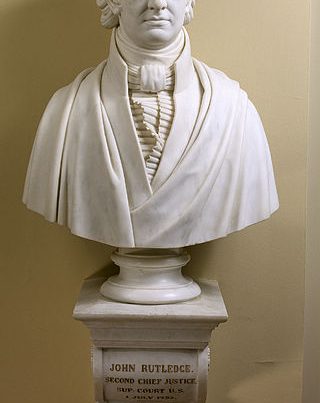Most people who visit or live in Columbus, Georgia probably don’t realize that one of the most famous houses in American literature sits on a back street near Lakebottom Park in the midtown section of the city. The impressive Greek revival home, first named El Dorado, was built by Colonel Seaborn Jones between 1828 and 1833. Jones’ daughter married Hennry L. Benning, the famous lawyer, judge, and Confederate general and namesake of Fort Benning, Georgia. Milliard Fillmore, James K. Polk, Henry Clay, and Winfield Scott were all guests at the property, but it is more well known for the Southern belle who finished the popular novel St. Elmo there in 1866, Augusta Jane Evans Wilson, born on this day (May 8) in 1835.
Wilson’s family was from South Carolina. She was the oldest of eight children and was largely educated at home by her mother. The family moved to Texas in the early 1840s but returned east to Alabama in 1849, settling in Mobile. Wilson wrote her first novel at fifteen or sixteen while the family was still living in Texas. Every one of her works had a female lead, and Wilson lived much of her life through her characters. They shared her political, religious, and societal views, and her heroines were model women: chaste, moral, intelligent, strong, honest, and dedicated. They were what she intended women to be and what she though society needed from the fairer sex. Wilson called this woman “the real woman.” Women were to be the spiritual and moral guides of men, the glue that held the fabric of a people together.
Her two most important works were published during the turbulent 1860s. The first, Macaria or Alters of Sacrifice, was dedicated to the Confederate soldier and the women who sacrificed on the home front during the War Between the States. They were fighting, in her words, to “deliver the South from despotism” and to win “constitutional republican liberty.” She wrote the book by candlelight while serving as a nurse to wounded Confederate soldiers, her mind never far from the horrors of war or the cause for which they bled. She could not serve in the army, but Wilson hoped her literary offering would galvanize the Southern spirit and deliver a victory on the battlefield. Macaria was popular in both the North and South and was smuggled through Northern lines during the War. One general ordered it burned because of the influence it had on his men. If Southerners could not be reduced to a brood of ignorant, treasonous, rebelling hayseeds, then it would be better to have a truer image burned than to sway minds in their favor.
Wilson understood that the world was watching the Confederacy. She desired that the Southern people become a beacon of artistic and literacy achievement. Her character Electra wished for the Confederacy, in the days after their victory, to be a “marble-hearted land…which Southern genius can mold into monuments of imperishable beauty. This war furnishes instances of heroism before which all other records pale, and our Poets, Sculptors, and Painters have only to look around them for subjects which Greek or Italian Art would glorify and immortalize.” Women, of course, were the societal backbone. Left at home during the War, they were cultivating an artistic spirit unmatched since the ancient world. Wilson saturated this work and others with references to Greek, Roman, and Egyptian history. Her understanding of political philosophy was second to none, and her accuracy in depicting human nature was superb. Wilson was no flirty, weak-minded, giggling girl. She deplored and destroyed that stereotype. Her characters gave themselves to romance and to men, but they, through their moral compass, dictated the terms.
She made this clear in her masterpiece, St. Elmo, published in 1866. Wilson held women’s suffrage in low regard and scoffed at what she called “blue-stockings,” educated women who shunned the traditional role of wife, mother, and care-giver for politics and speaking engagements. Her anti-suffrage position puts her out of touch with modern society, but she was not alone in the nineteenth century, and while the modern reader may laugh at her quaint provincialism, her reasoning, made clear in St. Elmo, stemmed from her faith and dedication to “womankind.”
The main character in St. Elmo, Edna Earl, is a devout, pious, pure, well-read, beautiful, and intelligent young woman, the model of Christian virtue. She falls in love with an immoral scoundrel, St. Elmo, but does not allow herself to express her interest because he is unworthy of her love. She pities him and prays for him, and though her heart is his, she never betrays her feelings. As a result, she spends much of her young life engaged in study, in nursing sick children, writing critically acclaimed books and articles, and fighting off suitors of a high social status (and money) but who cannot win her pure heart. In the end, Edna is able to reform St. Elmo. He returns to Christ, becomes a minister, and marries Edna. While a great romance, St. Elmo is also a political tale with interwoven social critique.
For example, Wilson, through Edna Earl, believed that women should jealously “contend for every woman’s right which God and nature had decreed the sex. The right to be learned, wise, noble, useful, in woman’s divinely limited sphere; the right to influence and exalt the circle in which she moved; the right to mount the sanctified beam of her own quiet hearthstone; the right to modify and direct her husband’s opinions….the right to make her children ornaments to their nation….the right to advise, to plead, to pray; the right to make her desk a Delphi, if God so permitted; the right to be all that the phrase ‘noble, Christian woman’ means.” She also cautioned against women being involved in anything that may “trail her heaven-born purity through the dust and mire of political strife….”
Wilson emphasized that:
The tendency of the age was to equality and communism, and this, she contended was undermining the golden thrones shining in the blessed and hallowed light of the hearth, whence every true woman ruled the realm of her own family. Regarding every pseudo ‘reform’ which struck down the social and political distinction of the sexes, as a blow that crushed one of the pillars of woman’s throne, she earnestly warned the Crowned Heads of the danger to be apprehended from the unfortunate and deluded female malcontents….and to proud happy mothers, guarded by Praetorian bands of children, she reiterated the assurance that ‘Those who rock the cradle rule the world.’ Most carefully she sifted the records of history, tracing in every epoch the sovereigns of the hearth-throne who had reigned wisely and contentedly, ennobling and refining humanity; and she proved by illustrious examples that the borders of the feminine realm could not be enlarged, without rendering the throne unsteady, and subverting God’s law of order.
She reiterated that politics never proved to be the salvation of the human race. Women, most importantly mothers and wives, had long been the calming factor, the guiding hand, and the nurturing vessel of a prosperous and peaceful people. Wilson argued neither voting nor political offices were necessary when women already held such power over men.
Critics complained that Wilson’s writing style was too pedantic and that her heroines often “swallowed an unabridged dictionary.” St. Elmo is difficult to wade through at times. Wilson’s use of historical references and religious imagery places a strain on the reader, but the book was widely popular and would have been a “best seller” in modern times.
Wilson did not marry until 1868. She spent the next forty years of her life in Mobile, Alabama. She wrote several more books, all dedicated to the virtues of the “noble, Christian woman” and the difficulties women faced in the modern age. She died in 1909, but for women in the late-nineteenth and early-twentieth centuries, her St. Elmo proved to be a handbook for the ideal traditional woman. Women in her generation read it and then required their daughters and granddaughters to read it. If nothing more, Wilson should be respected for her dedication to the hearth and home, to the moral fabric of America and the idea that women are strong and intelligent, and most importantly can mold future generations by their actions at home. They set the standard.
Most of this essay is included in the chapter “Traditional Women,” in my The Politically Incorrect Guide to Real American Heroes.







